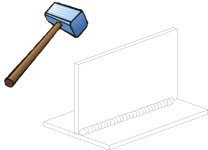Perplexed
Silver Member
Recently, I bought a Hot Max 135 amp MIG welder kit, and it came with a spool of 0.030 flux core wire, so I decided to start practicing with that wire. I got two pieces of 3/16" mild steel - one was a sheet about a foot square, the other was a rectangular piece about four inches wide and eight inches long. I wire-brushed the two pieces until they were relatively clean, then I used a 90-degree clamp to set the smaller piece perpendicular to the bigger piece. I set the welder's amperage and feed rates according to the diagram on the lid, and started welding. After several attempts where I consulted a welding guide (too much stick out, and too fast a feed, at first), knocking the smaller piece off and cleaning it up before setting it back in place, I am now at a point where I can produce somewhat smooth welds with a convex surface. However, I noticed there's not much penetration being made into the two pieces of steel; according to the guide, the amperage setting on the welder is too low. I bumped it up one notch (from "C" to "D" on a range from "A" to "J"), but still got minimal penetration into the steel. The welder is rated for up to 5/16 steel; I was wondering if I should keep bumping the amperage knob until I get satisfactory penetration? Right now, there's at most about 1 mm of penetration in some parts of the weld, while in other parts there's just surface discoloration. No discoloration at all on the other side of each piece of metal. Parts of the weld also seem to be sitting on the surface of the metal pieces. What can happen if I go too high with the amperage - will the welder shut down, or will there be burn-through in the steel or something worse? Any suggestions or advice would be welcome!


